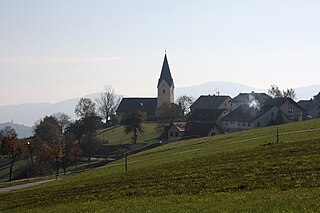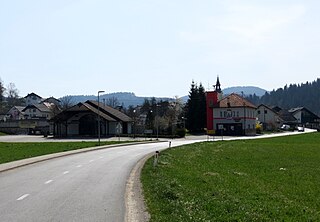
Brezje pri Tržiču is a settlement in the Municipality of Tržič in the Upper Carniola region of Slovenia. It is located near the road from Tržič to Begunje. In 2002 it had a population of 361.

Straža pri Raki is a settlement east of Raka in the Municipality of Krško in eastern Slovenia. The area was traditionally part of Lower Carniola. It is now included with the rest of the municipality in the Lower Sava Statistical Region.

Gora pri Pečah is a settlement in the Municipality of Moravče in central Slovenia. Traditionally the area was part of Upper Carniola. It is now included with the rest of the municipality in the Central Slovenia Statistical Region.

Turje is a settlement in the hills southeast of Dol in the Municipality of Hrastnik in central Slovenia. Traditionally the area was part of the Styria region. It is now included with the rest of the municipality in the Central Sava Statistical Region.

Lemberg pri Novi Cerkvi is a village in the Municipality of Vojnik in eastern Slovenia. The area was traditionally part of the Styria region. It is now included with the rest of the municipality in the Savinja Statistical Region.

Gorenje pri Zrečah is a settlement in the Municipality of Zreče in northeastern Slovenia. The area was traditionally part of the Styria region. It is now included with the rest of the municipality in the Savinja Statistical Region.

Miklavž pri Taboru is a dispersed settlement in the Municipality of Tabor in central Slovenia. The area is part of the traditional region of Styria. The municipality is now included in the Savinja Statistical Region.

Sveti Jernej is a village in the Municipality of Slovenske Konjice in eastern Slovenia. The area is part of the traditional region of Styria. The municipality is now included in the Savinja Statistical Region.

Brecljevo is a settlement in the Municipality of Šmarje pri Jelšah in eastern Slovenia. It lies in the hills south of Šmarje. The area was traditionally part of Styria. The municipality is now included in the Savinja Statistical Region.

Vršna Vas is a dispersed settlement in the hills south of Šmarje pri Jelšah in eastern Slovenia. The area is part of Styria and is included in the Savinja Statistical Region. It is a scattered village on a ridge and slope on either side of Zibika Creek. It includes the hamlets of Planinca and Sveta Magdalena.

Vinski Vrh pri Šmarju is a small settlement in the Municipality of Šmarje pri Jelšah in eastern Slovenia. It lies in the hills south of Šmarje. The area is part of the historical Styria region. The municipality is now included in the Savinja Statistical Region.

Močle is a village in the Municipality of Šmarje pri Jelšah in eastern Slovenia. It lies in the hills west of Šmarje. The area is part of the historical Styria region. The municipality is now included in the Savinja Statistical Region. It is a clustered village on the south side of a gentle slope. It includes the hamlets of Erpoge and Sveti Lovrenc.

Pečica is a settlement in the Municipality of Šmarje pri Jelšah in eastern Slovenia. It lies in the hills north of Sladka Gora. The area is part of the historical Styria region. The municipality is now included in the Savinja Statistical Region.

Jakob pri Šentjurju is a settlement south of Šentjur in eastern Slovenia. The area is part of the historical region of Styria. The Municipality of Šentjur is now included in the Savinja Statistical Region.

Šentvid pri Planini is a village east of Planina pri Sevnici in the Municipality of Šentjur in eastern Slovenia. The area is part of the historical Styria region. The municipality is now included in the Savinja Statistical Region.

Primož pri Šentjurju is a settlement in the Municipality of Šentjur in eastern Slovenia. The area is part of the historical Styria region. The municipality is now included in the Savinja Statistical Region. The settlement includes the hamlets of Bozne, Brezne, Grabne, and Kote.

Štefan pri Trebnjem is a small village in the Municipality of Trebnje in eastern Slovenia. It lies on the left bank of the Temenica River just west of Trebnje. The area is part of the historical region of Lower Carniola. The municipality is now included in the Southeast Slovenia Statistical Region.

Šent Jurij is a village in the Municipality of Grosuplje in central Slovenia. The area is part of the historical region of Lower Carniola. The municipality is now included in the Central Slovenia Statistical Region.

Šentpavel na Dolenjskem is a settlement just east of Šentvid pri Stični in the Municipality of Ivančna Gorica in central Slovenia. The area is part of the historical region of Lower Carniola. The municipality is now included in the Central Slovenia Statistical Region. It includes the hamlets of Grumlof, and Mandrga.














